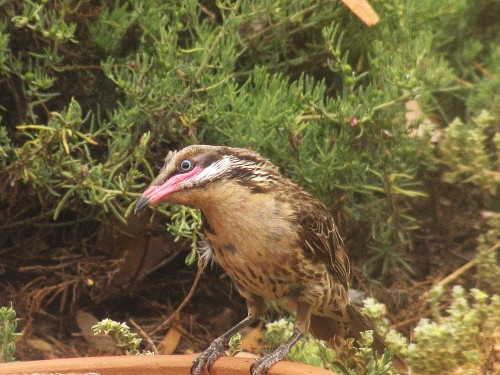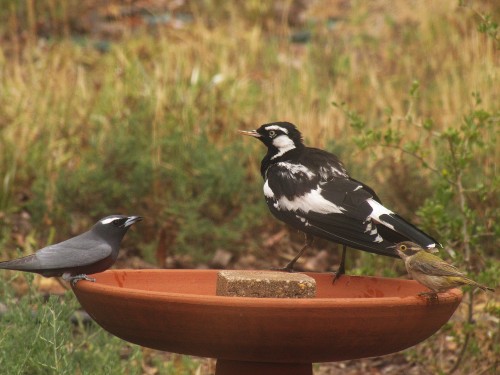Give the birds a treat for Christmas
Merry Christmas Everyone
I wish all of my readers a very merry and blessed Christmas, wherever you are.
I would be really pleased to get greetings from you – just use the “comments” section above.
Birds in the hot Australian sun:
Many parts of Australia are in the grips of an early, very hot summer, and this is especially so here in South Australia. Our capital city of Adelaide last week had a record December heatwave for over a hundred years with a string of 4 days over 40C. Yesterday was another very hot day at around 37C and today, Christmas Day, the forecast is for 38C. This will make it the hottest Christmas Day since 1945.
During hot conditions like these our birds suffer terribly. All of my Australian readers – and readers everywhere suffering in the hot, summer sun – I would like to encourage to buy a bird bath for their garden. Even putting a few old bowls or dishes of water around the garden is better than nothing.
We have had three bird baths strategically placed in our garden for many years. These have been placed so that we can watch from the room which we use the most. Many of the photos which I have used on this site were taken from that room, including that of a Spiny-cheeked Honeyeater shown above, and taken in the heatwave last week..
Two days ago our daughter arrived home for the Christmas break and doubled our number of bird baths. Our children have given us three new bird baths. I hope this doubles the number of photos I can take!
I hope that you have a great Christmas and a wonderful New Year.
Trevor
Further reading:
- Spiny-cheeked honeyeater on a hot day
- Make room for me – White-winged Choughs get a little crowded at the bird bath
- Time for a bath – a list of bird and non-bird visitors to our bird baths


Happy new year Trevor!
Big thank you for maintaining your site..
I’m in suburban Adelaide, and I put a second bath into the garden when the hot weather struck early In the season. We have always had a terracotta pot pond with water Lillie’s that allows for the bees to drink as well having a strong enough rim for some of the larger birds. The other two are just very large terracotta pot saucers, one on the ground, the other now in a raised garden bed under a deep shade tree.
The ring neck dove nested and fledged a chick in a hanging pot under the verandah.. Much cooler than her previous nest . Blackbird got it wrong and build a nest behind the fence post on the support rail .. But the iron faces west and is only shaded part of the day. She sat the nest for a full week before abandoning it, I suspect it was far too hot once the sun tracked round.. Unfortunately, mid year, the neighbors had removed the large shrubs many of them had been using
The NH honeyeaters, the blackbird and the wattlebirds have all now learnt to associate me out watering with a wet foliage cool off. The honeyeaters will actually make a fuss until I wet the bamboo down to make a cool and safe retreat then happily make use of it regardless of how close I am 🙂 I suspect they may nest in the bamboo next year as its big enough to be a stable thicket
All of them love it when the old fashioned rain wave sprinkler is put on…
They all seem to be learning new tricks to cope with the extra heat … with a little help from their friends..
Cheers
Hi Sue,
Happy New Year to you too.
Thank you for visiting my site and for leaving such a wonderful account of the birds in your garden. Treating the birds in the way that you do certainly enhances our lives – we get a great deal of enjoyment from seeing the birds in our garden here in Murray Bridge.
I was really encouraged by what you have written here that I have taken your comments and featured them in a separate, new article – with a little editing.
I hope that you don’t mind – it is easily removed if you don’t want me to do this.
The reason for featuring your experiences in a new article is that only a handful of readers will see your comments on this article. On a new article, however, many more people will read your comments (I get several hundred readers every day from all over the world.)
Thanks again,
Trevor
Gosh, blush 🙂
Don’t mind at all… If it’s at all useful, please do as you will and correct or edit as required 🙂
If it reminds someone to think about the birds in their yard, all the better..
Urban infill may be good land utilization for us (debateable) but its generally not good for wildlife… Concrete everywhere trapping heat, airconditioners with noise, vibration and more hot air.. All the big trees in my cbd fringe suburb are disappearing as old blocks are divided and existing old homes are extended fence to fence. It’s called densification but really means desertification
I still have a ( small ) garden. Only 5m from walls to fence on one side, a whole 8 m to the fence on other two sides, in that i have two ancient peppercorn trees in the back , and two large sugar gums out front ..but the suburb from the air is getting very sparse!
Often our visitors comment favourably on the ‘many’ birds they hear and see… Our last Japanese exchange student couldnt belive we had parrots in our garden! It’s a disrupted assemblage.. Not all native or endemic, but it’s better than a silence of hot dry concrete..
If only other urban dwellers would think about a little patch of green as being an important patchwork block in a birds overall range, not as a wasted opportunity to enlarge the concrete entertainment area 🙂
Cheers